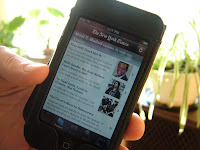
No, e-readers won't save journalism -- at least not the kind that the author and the Columbia Journalism Review practice.This last point about competition deserves a little additional commentary. I've been thinking a lot about the competitive environment for online news. Publishers assume people want news, when in actuality many of them just want information. Increasingly, it's not so important where that information comes from.
Consider the people reading this essay. What percentage of readers are consuming it on an e-reader, iPod, iPad, Android phone, or any other mobile device, relative to the percentage of readers who are looking at it on a PC or laptop screen? I suspect the mobile:PC ratio is quite small -- maybe just a few percentage points, if that (perhaps the CJR can let us know?). I further believe that even among those who are looking at it on a mobile device or e-reader, very few are reading it from start to finish. Like many publishers, the Columbia Journalism Review is still oriented toward long prose pieces that are a poor fit for mobile devices or the people who own them. Who is going to read a 4,546-word analysis (the length of this essay) on a small screen, or even a 1,000-word news article. How many would be willing to shell out subscription fees for long-form Time, Wired, or WaPo print content on a Nook or iPhone?
Even short-form content may be a stretch, when there are so many other free and low-cost distractions available on mobile devices. Publishers no longer have a monopoly on information or entertainment, like they did a decade ago, when tabloids, metro newspapers, books, magazines and CD walkmans were the staple on subway cars. Now when I look around at my fellow commuters, I see people playing games, listening to mp3s, texting, watching videos, checking Facebook for updates, and sometimes even looking at a newspaper or mobile news app. If people don't want to read a 2,000-word feature, or don't feel like paying for news (print or mobile), they still have too many free/cheaper options to choose from -- options that they didn't have before, because the technology wasn't widely available.
Consider product news. In the mid-1990s, when a new Apple product came out, the channels for information were far more restricted. People depended on the news media (and advertising) to find out about these products, because the only other channels were word-of-mouth and retail outlets. I don't need to pay to learn about the iPhone 4 from the New York Times' David Pogue (or, for that matter, and other news publisher), when I can get facts about the product from Apple.com, video from YouTube, and numerous opinions from blogs, message boards, and my online networks -- all for free. What extra value is Pogue delivering? Certainly, he's a great writer and is accurate and unbiased (well, most of the time), but is he worth $1 in print or a $n monthly subscription? I don't think so. Neither will most other people, when they are prompted to pay online or on their iPad.
Update March 2016: Six years after writing this post, I frequently read news articles on my iPhone. I also own a small-screen e-reader (a Kindle paperwhite) but I have found it difficult to read books or other long-form content. That said, millions of other people have adjusted to the new e-reader technology. I also have a digital publishing business that produces how-to guides, but sales of ebooks have actually leveled off or declined for most marketplaces while paperback sales have continued to grow. I don't think e-readers are the savior for long-form content
Sources and research: Columbia Journalism Review, New York Times/Bits, EdibleApple.com, Mediagazer
Image: New York Times iPhone app on the iPod touch. Creative Commons Generic License 2.0 -- you are free to use it for commercial or noncommercial work, as long as you credit the source (Ian Lamont) and link back to this blog post.
No comments:
Post a Comment
All comments will be reviewed before being published. Spam, off-topic or hateful comments will be removed.